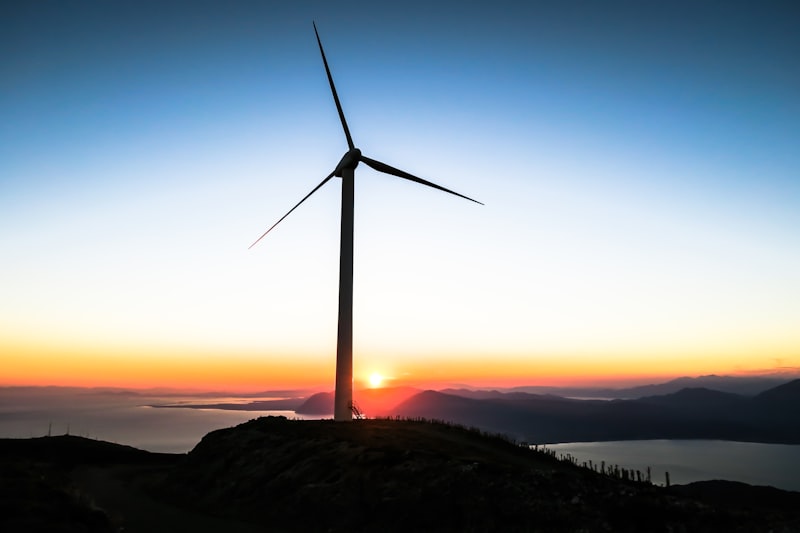Imagine a world where energy is harnessed from the sun’s inexhaustible rays, or where vast fields of wind turbines generate power without emissions. These are not just futuristic dreams but present-day realities driving a global economic transformation. Investors keen on long-term sustainability and profitability are eyeing renewable energy as a cornerstone of their portfolios.
The benefits are compelling. Renewable energy projects often benefit from governmental incentives and subsidies, making them financially attractive. Moreover, as technology advances and economies of scale kick in, the cost of renewable energy production continues to drop, enhancing profitability for investors.
But it’s not just about financial returns. Investing in renewable energy carries a profound sense of contributing to a cleaner environment. It’s about reducing carbon footprints, mitigating climate change effects, and ensuring energy security for future generations.
Yet, challenges remain. The intermittent nature of some renewable sources, such as solar and wind, requires innovative storage solutions to ensure continuous supply. Regulatory landscapes can also be complex, varying widely across regions and affecting project feasibility.
Despite these challenges, the momentum is unmistakable. The global commitment to reducing greenhouse gas emissions, coupled with technological advancements, paints a promising picture for renewable energy investors. It’s not just an investment in today’s energy needs but a bet on a sustainable tomorrow.
Green Gold: Why Investing in Renewable Energy Is the Smart Choice
Unlike fossil fuels that contribute to climate change and air pollution, renewable energy sources offer a cleaner alternative. They harness natural elements that are endlessly renewable, such as sunlight and wind, making them not only environmentally friendly but also economically viable in the long run.
Consider the economic benefits: investing in renewable energy creates jobs in manufacturing, installation, and maintenance sectors. It fosters innovation and technological advancement, driving economic growth while reducing dependency on imported fuels. Countries investing in renewable energy also enhance their energy security, lessening vulnerability to geopolitical tensions and price fluctuations in the global energy market.
Moreover, investing in renewable energy sends a powerful message of environmental stewardship. It’s about preserving our planet for future generations, reducing carbon emissions, and mitigating the impacts of climate change. Every megawatt of renewable energy generated translates to fewer greenhouse gases emitted into the atmosphere.

But beyond the numbers and environmental benefits, investing in “Green Gold” is about shaping a sustainable future. It’s about embracing technologies that not only meet our energy needs today but also ensure a thriving planet tomorrow. Just as gold has been treasured throughout history, renewable energy is becoming increasingly precious in our modern world—a beacon of hope for a cleaner, brighter future.
The Rise of Renewables: Opportunities and Challenges for Investors
Investors keen on exploring opportunities in renewables are met with a promising landscape. The global shift towards clean energy is driven by technological advancements and supportive government policies aimed at reducing carbon footprints. This transition not only addresses environmental concerns but also opens up new avenues for financial growth.

One of the most attractive aspects for investors is the potential for substantial returns in the renewable energy market. As demand for clean energy solutions grows, so does the market value of companies specializing in renewables. Investing in solar panel manufacturers, wind turbine producers, or companies involved in energy storage technologies can yield significant profits as these sectors expand.
However, navigating the renewable energy market isn’t without its challenges. One major hurdle investors face is the inherent volatility of the sector. Fluctuations in government policies, changes in energy prices, and technological risks can impact investment returns. For instance, policy shifts towards or away from renewable incentives can influence market dynamics overnight.
Moreover, the capital-intensive nature of renewable energy projects requires substantial upfront investments. This financial commitment may deter some investors who prefer quicker returns or lower-risk profiles. Additionally, the competitive landscape within renewables means that only companies with strong technological innovation and strategic positioning will thrive in the long term.

Despite these challenges, the renewable energy sector continues to attract investors motivated by the potential for both financial and environmental returns. By strategically navigating the opportunities and challenges presented, investors can contribute to a sustainable future while reaping the rewards of a rapidly evolving market.
From Sun to Wind: Exploring the Diverse Landscape of Renewable Investments
Solar energy stands as a beacon of innovation, harnessing the power of sunlight through photovoltaic panels to generate electricity. This technology has evolved rapidly, becoming more efficient and cost-effective over the years. Investors keen on solar projects can capitalize on government incentives, such as tax credits and grants, aimed at boosting renewable energy adoption. The allure lies not only in contributing to a greener planet but also in the long-term economic benefits of reduced operational costs and energy independence.
On the other hand, wind energy represents a dynamic force in the renewable sector, literally capturing the power of moving air masses to produce electricity through turbines. Wind farms, often located in regions with consistent wind patterns like coastal areas or plains, offer investors a robust option for diversifying their portfolios. With advancements in turbine technology and grid integration, wind power has become a reliable source of clean energy, capable of powering communities and industries alike.
Both solar and wind investments share common advantages. They are inherently scalable, allowing investors to start with small projects and expand as confidence and expertise grow. Moreover, these investments hedge against future energy price fluctuations, providing a stable financial outlook amidst global energy market uncertainties.
As the world transitions towards a low-carbon economy, the appeal of renewable energy investments continues to grow. Beyond financial rewards, investors play a crucial role in driving innovation and accelerating the shift towards sustainable energy solutions. Whether opting for solar panels gleaming under the sun or wind turbines spinning gracefully in the breeze, each investment contributes to a brighter, cleaner future for generations to come.
Future-Proofing Portfolios: How Renewable Energy Investments Secure Returns
One of the key reasons why renewable energy investments are seen as a secure bet lies in their resilience to market fluctuations. Unlike traditional fossil fuel-based industries, renewable energy sectors such as solar, wind, and hydroelectric power are less susceptible to geopolitical tensions and price volatility. This stability ensures that returns on investment remain steady over the long term, shielding portfolios from sudden downturns and economic shocks.
Moreover, the regulatory landscape is increasingly favoring renewable energy initiatives. Governments worldwide are implementing policies and incentives to promote clean energy production and consumption. This favorable regulatory environment not only reduces investment risks but also enhances profitability by lowering operational costs and expanding market opportunities.
From a financial standpoint, renewable energy projects often offer attractive returns on investment (ROI). Advances in technology have significantly reduced production costs, making renewable energy sources increasingly competitive with traditional energy sources. Investors can capitalize on these cost efficiencies to generate robust returns while contributing to sustainable development goals.
Investing in renewable energy isn’t just about maximizing financial returns; it’s also about investing in a cleaner, more sustainable future. By allocating capital towards renewable energy projects, investors play a crucial role in combating climate change and reducing carbon emissions. This dual benefit of financial profitability and environmental stewardship underscores the growing appeal of renewable energy investments in today’s investment landscape.
Future-proofing portfolios through renewable energy investments isn’t merely a prudent financial strategy; it’s a commitment to sustainability and responsible investing. As the world transitions towards a low-carbon economy, investing in renewable energy offers a compelling opportunity to secure returns while making a positive impact on the planet.
Beyond Fossil Fuels: How Renewable Energy Is Reshaping Investment Strategies
Investors are increasingly turning their attention to renewable energy for several compelling reasons. Firstly, the sustainability factor plays a crucial role. Unlike finite fossil fuels, renewable energy sources are essentially boundless. This longevity translates into more stable and predictable long-term investments, shielding portfolios from the volatility often associated with traditional energy sectors.
Moreover, the global push towards sustainability and reducing carbon footprints has led governments and businesses alike to incentivize renewable energy projects. This support ranges from tax incentives to favorable regulatory policies, making investments in renewables not only financially attractive but also aligned with broader societal and environmental goals.
Consider the analogy of a marathon versus a sprint: while fossil fuels offer immediate energy gains, they deplete over time, akin to sprinting a short distance. In contrast, renewables function like a marathon, providing sustained energy outputs without the risk of depletion. This endurance makes them a safer bet for investors looking to secure long-term returns and mitigate risks associated with fossil fuel dependency.
Rhetorical questions naturally arise: Why bet on a dwindling resource when the sun shines perpetually, and the wind blows continuously? These renewable sources, once considered niche, have now matured into robust industries capable of competing head-to-head with traditional energy giants. The smart money sees this shift and aligns investment strategies accordingly, diversifying portfolios to include assets that not only promise financial returns but also contribute positively to a sustainable future.
The era of fossil fuels is gradually yielding to the rise of renewable energy investments. This paradigm shift isn’t just a trend but a pivotal evolution in how we harness and invest in energy. As investors navigate this new landscape, the wisdom lies in recognizing that the future belongs to those who embrace sustainable energy solutions today.
Investing in Innovation: The Technological Advances Driving Renewable Energy
Take solar energy, for example. The development of advanced photovoltaic cells has significantly boosted solar power’s efficiency and affordability. New materials and manufacturing techniques have made solar panels lighter, more durable, and capable of generating more electricity from sunlight. This breakthrough has democratized solar energy, allowing homeowners and businesses alike to harness clean power from their rooftops.
Similarly, wind energy has seen remarkable advancements. Modern wind turbines are taller and more efficient, capturing more wind energy at higher altitudes where winds are stronger and more consistent. Improved blade designs and materials have increased turbine efficiency while reducing maintenance costs. These innovations have turned wind farms into potent sources of renewable electricity, capable of powering entire communities.
In the realm of hydroelectric power, innovations in turbine technology have optimized energy production from flowing water. Advanced designs minimize environmental impact while maximizing energy output, making hydroelectric dams a reliable source of clean electricity worldwide. These technological strides underscore the potential of renewable energy to meet global energy demands sustainably.

As we continue to invest in these innovations, the future of renewable energy looks promising. Each advancement brings us closer to a world where clean, abundant energy powers our homes, industries, and economies without harming the planet. By supporting technological breakthroughs and fostering innovation, we pave the way for a brighter, more sustainable future for generations to come.
Frequently Asked Questions
What are the risks associated with investing in renewable energy?
Learn about the risks associated with investing in renewable energy, including regulatory changes, technological uncertainties, and market volatility. Understand how these factors can impact investment returns and what strategies investors can adopt to mitigate these risks.
What trends are shaping the future of renewable energy investments?
Discover the key trends influencing future investments in renewable energy, from advancements in storage technologies to increasing government policies favoring sustainability. Stay informed to capitalize on emerging opportunities in this rapidly evolving sector.
How can individuals start investing in renewable energy projects?
Learn how individuals can begin investing in renewable energy projects, covering options like crowdfunding platforms, renewable energy mutual funds, and direct investments in solar or wind farms.
How does government policy influence investments in renewable energy?
Discover how government policies can significantly impact investments in renewable energy, shaping incentives, funding opportunities, and regulatory frameworks to accelerate sustainable energy projects.
What are the main benefits of investing in renewable energy?
Discover the primary advantages of investing in renewable energy sources. Learn how these investments contribute to sustainability, reduce environmental impact, and offer long-term cost savings while promoting energy independence.




[…] Investing in Renewable Energy: Future Prospects […]
[…] Investing in Renewable Energy: Future Prospects […]
[…] Investing in Renewable Energy: Future Prospects […]
[…] Investing in Renewable Energy: Future Prospects […]
[…] Investing in Renewable Energy: Future Prospects […]
[…] Investing in Renewable Energy: Future Prospects […]
[…] Investing in Renewable Energy: Future Prospects […]
[…] Investing in Renewable Energy: Future Prospects […]
[…] Investing in Renewable Energy: Future Prospects […]
[…] Investing in Renewable Energy: Future Prospects […]
[…] Investing in Renewable Energy: Future Prospects […]
[…] Investing in Renewable Energy: Future Prospects […]
[…] Investing in Renewable Energy: Future Prospects […]
[…] Investing in Renewable Energy: Future Prospects […]
[…] Investing in Renewable Energy: Future Prospects […]
[…] Investing in Renewable Energy: Future Prospects […]
[…] Investing in Renewable Energy: Future Prospects […]
[…] Investing in Renewable Energy: Future Prospects […]
[…] Investing in Renewable Energy: Future Prospects […]
[…] Investing in Renewable Energy: Future Prospects […]
[…] Investing in Renewable Energy: Future Prospects […]
[…] Investing in Renewable Energy: Future Prospects […]
[…] Investing in Renewable Energy: Future Prospects […]
[…] Investing in Renewable Energy: Future Prospects […]
[…] Investing in Renewable Energy: Future Prospects […]